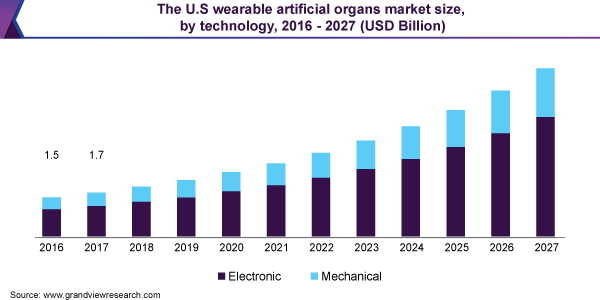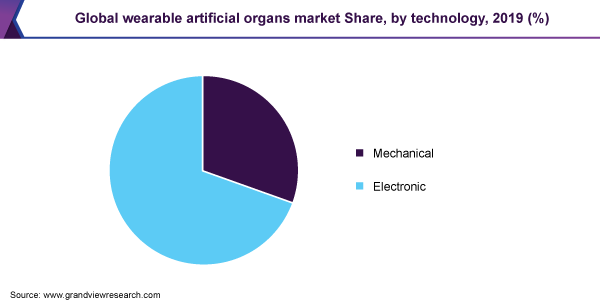- Home
- »
- Medical Devices
- »
-
Wearable Artificial Organs Market Size Report, 2020-2027GVR Report cover
![Wearable Artificial Organs Market Size, Share & Trends Report]()
Wearable Artificial Organs Market Size, Share & Trends Analysis Report By Product (Kidney, Cochlear Implant, Exoskeleton, Vision Bionics, Brain Bionics), By Technology (Mechanical, Electronic), By Region, And Segment Forecasts, 2020 - 2027
- Report ID: GVR-4-68038-842-8
- Number of Pages: 110
- Format: Electronic (PDF)
- Historical Range: 2016 - 2018
- Industry: Healthcare
Report Overview
The global wearable artificial organs market size was valued at USD 5.4 billion in 2019 and is expected to grow at a compound annual growth rate (CAGR) of 16.2% from 2020 to 2027. Increasing demand and supply gap of organ donors coupled with the rising incidence of organ failure is driving the market. Technological advancement coupled with continuous investments in research and development for wearable artificial organs is also boosting the market growth. The artificial organ is an engineered device integrated into human living tissues to replace the human organ. The demand for wearable artificial organs is on the rise owing to the increasing number of the geriatric populations prone to kidney failure and less cost of wearable artificial organs compare to organ transplantation. Major players in the industry are focusing on the development of wearable artificial organs for the disease that cannot be cured with alternative methods. Wearable and portable devices would potentially improve quality of life by allowing patients to continue their daily activities while undergoing dialysis or therapy.

Advancement in the field of genetic engineering, stem cell, microelectronics, nanotechnology, genomics, proteomics, artificial intelligence, and bioinformatics is creating new avenues for wearable artificial organs. Manufacturers in the industry are focused on biological replacement and organ repair that will function as a tissue-based artificial organ and mimics an organ’s physiological function. These devices are individualized to the patient’s changing needs. The market for wearable artificial organs is moving from mechanical alternative towards real biological replacement. Moreover, these devices are less expensive compared to organ transplants, thereby, creating demand and new opportunities in the market.
Developing healthcare infrastructure and reducing waiting time for FDA approval are also some of the factors augmenting the market growth. For instance, in August 2019, FDA approved MED-EL Cochlear Implant System for single-sided deafness and asymmetric hearing loss. This system is used for children 5 years and older. Increasing incidence of road accidence and a high number of permanent injuries are also creating demand for wearable artificial organs. According to the World Health Organization, approximately 1.4 million people die in a road accident every year, and between 20 to 50 million people suffer from non-fatal injuries.
Product Insights
The cochlear implant dominated the market for wearable artificial organs and accounted for a revenue share of 30.1% in 2019, owing to frequent product launches. Based on the product, the market is segmented into wearable artificial kidney, pancreas, cochlear implant, exoskeleton, brain bionics, and vision bionics. In December 2019, the FDA approved the first active Osseointegrated steady-state implant which can be used for children 12 years and older with single-sided sensorineural deafness. The device would help in improving the patient’s ability to hear in both noisy and quiet situations.
The wearable artificial kidney segment is expected to grow at an exponential rate owing to the increasing incidence of kidney failure and the shortage of organ donors. According to the National Kidney Foundation, there are 121,678 people on the waiting list for organ transplants in the U.S. and of these approximately 100,791 people are waiting for a kidney transplant. Acute shortage of kidney donors and the increasing number of kidney failure is creating the demand for the wearable artificial kidney in the market.
Technology Insights
Electronic wearable artificial organs dominated the market for wearable artificial organs and accounted for a revenue share of 69.6% in 2019, owing to technological advancement and increasing adoption of these devices. Based on technology, the market is segmented into mechanical and electronic. The demand for electronic wearable prosthetics among amputees is increasing. Electronic and battery systems are used to create nerve and muscle movement in the residual organ. These devices are creating a revolution in the medical electronics industry. The market is expected to witness innovative product launches in the near future. For instance, in June 2020, Medtronic presented the positive results of its artificial pancreas MiniMed 780G System. The device would deliver both correction boluses and basal insulin in every five minutes to help patients to avoid high and lows of insulin with greater ease.

The mechanical wearable devices segment is expected to witness a CAGR of 15.6% during the forecast period. The key drivers of the segment are the rising adoption of these devices and the increasing number of product launches. Furthermore, increasing research on mechanical wearable limbs and exoskeleton is also boosting the demand. These mechanical devices are lightweight, cheap, and easy to build and repair. Thus, increasing investment in mechanical wearable technology and growth in purchasing power of patients is likely to boost the market growth.
Regional Insights
North America dominated the market and accounted for a revenue share of 46.1% in 2019. The region is expected to witness an increase in the number of product launches and technological development in the field of 3D printing. Furthermore, increasing research and development expenditure and speedy FDA approvals of these devices are also boosting the demand in the region. The presence of major players and highly sophisticated healthcare infrastructure is also boosting the demand in the region. In North America, the U.S. dominated the market owing to the factors such as large patient pool, favorable reimbursement policies, and increasing shortage of organ donors.
Asia Pacific market is expected to see exponential growth owing to the presence of a large patient pool and high incidence of organ failure. Furthermore, drastic changes in medical technology in the field of 3D printing and artificial intelligence are also boosting growth. The region is expected to transform the regulatory framework which is adaptable, contemporary, and support innovation. Many government programs in the field of 3D printing, industrial applications of the Internet of Things (IoT), and robotics are expected to open new avenues for the wearable artificial organ market. According to the Department of Industry, Science, Energy, and Resources, the Australian government is supporting advanced manufacturing facilities for robotic, automation, artificial intelligence, machine learning, nanotechnology, and additive manufacturing of 3D printing. Thus, these government initiatives anticipated to boost investment in the development of technologies and fuel further research.
Key Companies & Market share Insights
The market is highly fragmented with the presence of many large, small, and medium-scale vendors. The key players are heavily investing in research and development and expanding their manufacturing facilities to cater to the rising demand for wearable artificial organs in the market. Furthermore, with the increasing healthcare expenditure and rising adoption of these innovative devices, the market is expected to witness continuous scientific development in the field of medical electronics. Rising merger and acquisition of major players and technological collaboration are expected to create new opportunities in new opportunities in the market. For instance, in December 2019, AWAK Technologies raised USD 40.0 million to continue the development of wearable peritoneal dialysis devices. In December 2018, Sensorion announced a strategic collaboration with Cochlear Limited to study combination therapies for cochlear implant patients. Cochlear Limited is involved in more than 100 research collaborations in 20 countries. Some of the prominent players in the wearable artificial organs market include:
-
Medtronic
-
AWAK Technology
-
Second Sight Medical Products, Inc
-
Cochlear Ltd
-
Ekso bionics
-
MED-EL
-
Abbott Laboratories
-
Boston Scientific
-
HDT Global
-
Touch Bionics, Inc
-
Neurotron Biotechnology
-
Retina Implant AG
-
ReWalk Robotics
-
Rex Bionics Plc
-
Suit X (U.S. Bionics Inc.)
-
Lockheed Martin Corporation
Wearable Artificial Organs Market Report Scope
Report Attribute
Details
Market size value in 2020
USD 6.2 billion
Revenue forecast in 2027
USD 17.7 billion
Growth Rate
CAGR of 16.2% from 2020 to 2027
Base year for estimation
2019
Historical data
2016 - 2018
Forecast period
2020 - 2027
Quantitative units
Revenue in USD million and CAGR from 2020 to 2027
Report coverage
Revenue forecast, company ranking, competitive landscape, growth factors, and trends
Segments covered
Product, technology, region
Regional scope
North America; Europe; Asia Pacific; Latin America; MEA
Country scope
The U.S.; Canada; The U.K.; Germany; France; Italy; Spain; China; Japan; India; South Korea; Australia; Mexico; Brazil; Argentina; Colombia; South Africa; Saudi Arabia; UAE
Key companies profiled
Medtronic; AWAK Technology; Second Sight Medical Products, Inc.; Cochlear Ltd.; Ekso bionics; MED-EL; Abbott Laboratories; Boston Scientific; HDT Global; Touch Bionics, Inc.; Neurotron Biotechnology; Retina Implant AG; ReWalk Robotics; Rex Bionics Plc; Suit X (U.S. Bionics Inc.); Tandem Diabetes; Lockheed Martin Corporation
Customization scope
Free report customization (equivalent up to 8 analysts working days) with purchase. Addition or alteration to country, regional & segment scope.
Pricing and purchase options
Avail customized purchase options to meet your exact research needs. Explore purchase options
Segments Covered in the ReportThis report forecasts revenue growth at global, regional, and country levels and provides an analysis of the latest industry trends in each sub-segment from 2016 to 2027. For the purpose of this study, Grand View Research has segmented the global wearable artificial organs market on the basis of product, technology, and region:
-
Product Outlook (Revenue, USD Million, 2016 - 2027)
-
Kidney
-
Pancreas
-
Cochlear implants
-
Exoskeleton
-
Bionic Limbs
-
Brain Bionics
-
Vision Bionics
-
-
Technology Outlook (Revenue, USD Million, 2016 - 2027)
-
Mechanical
-
Electronic
-
-
Regional Outlook (Revenue, USD Million, 2016 - 2027)
-
North America
-
The U.S.
-
Canada
-
-
Europe
-
Germany
-
The U.K.
-
France
-
Italy
-
Spain
-
-
Asia Pacific
-
Japan
-
China
-
India
-
South Korea
-
Australia
-
-
Latin America
-
Brazil
-
Mexico
-
Argentina
-
Colombia
-
-
MEA
-
South Africa
-
Saudi Arabia
-
UAE
-
-
Frequently Asked Questions About This Report
b. The global wearable artificial organs market size was estimated at USD 5.4 billion in 2019 and is expected to reach USD 6.2 billion in 2020.
b. The global wearable artificial organs market is expected to grow at a compound annual growth rate of 16.2% from 2020 to 2027 to reach USD 17.7 billion by 2027.
b. North America dominated the wearable artificial organs market with a share of 28.9% in 2019. This is attributable to rising healthcare awareness coupled with cloud-based technologies acceptance and constant research and development initiatives.
b. Some key players operating in the wearable artificial organs market include Medtronic; AWAK Technology; Second Sight Medical Products, Inc.; Cochlear Ltd.; Ekso bionics; MED-EL; Abbott Laboratories; Boston Scientific; HDT Global; Touch Bionics, Inc.; Neurotron Biotechnology; Retina Implant AG; ReWalk Robotics; Rex Bionics Plc; Suit X (U.S. Bionics Inc.); Tandem Diabetes and Lockheed Martin Corporation.
b. Key factors that are driving the market growth include increasing medicare reimbursement for telehealth services, reducing emergency room visits and hospitalization rate, and technological innovation in communication technology across the world.
Share this report with your colleague or friend.
![gvr icn]()
NEED A CUSTOM REPORT?
We can customize every report - free of charge - including purchasing stand-alone sections or country-level reports, as well as offer affordable discounts for start-ups & universities. Contact us now
![Certified Icon]()
We are GDPR and CCPA compliant! Your transaction & personal information is safe and secure. For more details, please read our privacy policy.
We are committed towards customer satisfaction, and quality service.
"The quality of research they have done for us has been excellent."





